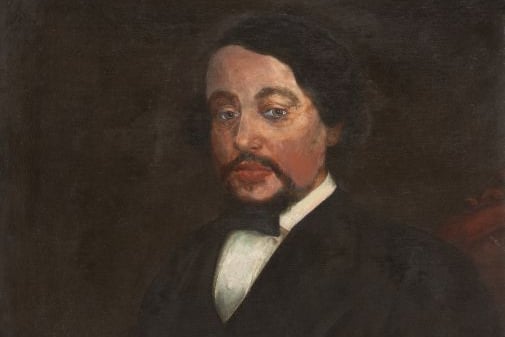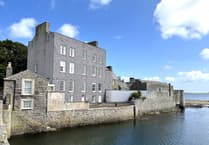A portrait identified as being of James Brown, founder of the Isle of Man Times newspaper, has been presented to Manx National Heritage by Media Isle of Man (formerly Isle of Man Newspapers), and is now on public display in the Manx Museum’s Art Gallery.
This historically important painting hung in the boardroom of Isle of Man Newspapers in Peel Road from 1994 to 2022, and latterly in the foyer at Media Isle of Man’s premises, James Brown House, in Finch Road. But its history is a complex one, with many unanswered questions, and it is hoped that local people with long memories may be able to fill in some of the gaps.
James Brown (1815–1881), the Liverpool-born grandson of a freed slave, arrived in the Isle of Man in 1846 to work as a printer, and founded the Isle of Man Times in 1861. His campaigning story was told in detail in Dr Robert Fyson’s book The Struggle for Manx Democracy (Culture Vannin, 2016). Several photographs of Brown during his imprisonment in Castle Rushen in 1864 were used in the book, along with a picture of his marble bust already in the Museum – but not this portrait.
The late Dr Fyson’s partner, retired journalist Valerie Cottle, explained: ‘This was simply because we didn’t know that the painting existed.’ It was brought to her attention only after a series of random coincidences late last year.
The inimitable Dot Tilbury, calling at James Brown House in connection with a cycling story, had spotted the portrait hanging in the foyer. She drew it to the attention of a friend, Judy Cross, a great-granddaughter of Brown’s, who had also not previously known of its existence.
Meanwhile, Judy had been approached for information by a young Oxford postgraduate, Carys Owen, who – because of Manx family connections (her grandmother was Castletown-born Mildred Looney, née Oates) – had chosen Photographs of a Political Prisoner: James Brown of the Isle of Man Times as the title of her History of Art & Visual Studies Master of Studies dissertation. Judy told her about the painting, which she duly included amongst her illustrations. Fast forward to its completion, and Carys sent Judy a printed copy of the dissertation, which Judy showed to Valerie because she knew she would be interested.
‘Alarm bells started to ring as soon as I saw the Brown portrait reproduced in Carys’s dissertation,’ said Valerie. ‘Because I realised immediately how important it was. If we’d known of its existence, Robert would certainly have included it in his book.’
Meanwhile, Judy’s husband Sandy found a story in the Isle of Man Weekly Times of 14th July 1981, reproducing the painting in a report about its sale in Chrystal’s saleroom. The story had been written by the late Margery West, who expressed her dismay not only that it had been put up for sale at all, but that it had ‘been knocked down for a mere £60 … a giveaway figure.’

‘The story behind the portrait merited a place for it in the Manx Museum,’ Margery wrote. ‘I couldn’t have agreed more,’ said Valerie, ‘but here we were more than 40 years later, and the portrait was still in private hands.’
Since coming to the Island in 1966, Valerie had worked in both the old Isle of Man Times building in Athol Street, and later in the Examiner office in Hill Street, but had never seen the portrait in either of them. A quick check amongst her surviving colleagues – the most venerable of them retired journalist Alan Bell – produced the same result: nobody had ever seen the painting before. Where had it been since it was painted, who had put it up for sale in 1981, and who had bought it?
Unfortunately, she discovered that the Chrystal’s saleroom records had been destroyed.
Yet people who worked for Isle of Man Newspapers in the early 1990s recall that the portrait ‘came down from the Examiner offices in Hill Street’ after the collapse of proprietor H.L. Dor’s newspaper empire in 1987, and was for a time stored in the cellar at their premises in Ridgeway Street. It migrated to their newly built Peel Road premises in 1994, and in 2022 came to Finch Road, bringing the Isle of Man Times founder’s name with it for the building, although the title is no longer in use.
In the painting, Brown holds a copy of the Isle of Man Times dated 24th February 1866, and the newspaper also bears the name of the artist, J.R. Siddall. This in itself has thrown up a number of interesting connections.
John R. Siddall was born in 1803 or ’4 in Alfreston, Derbyshire, and in 1835 married Louisa Bregazzi, from a family of Italian origin who were all picture-frame carvers and gilders. They were cousins to the Isle of Man Bregazzis, still notable today and mostly descended from Samuel Bregazzi, listed with his family in the 1841 Manx Census as carrying out exactly the same trade in Douglas. John Siddall used the Bregazzi showroom in Douglas to advertise himself as a portrait painter and to invite commissions.
He first advertised his services in Manx newspapers in 1856, and was still here in 1871, when he was named in the Census as ‘artist,’ lodging on Cambridge Terrace in Douglas. If he spent so much time here, he must surely have fulfilled quite a number of portrait commissions on the island. How many have survived, and where are they now?
Only three of his Manx commissions have been identified so far. Apart from the Brown portrait, a London saleroom was last year advertising a painting of ‘Eliza Maddock née Birtles of Onchan, Isle of Man, aged 17, by artist J.R. Siddall, 1866.’ And extensive reports appeared in both the Manx Sun and the Isle of Man Times in January 1871, when ‘a large oil painting, the work of Mr. J.R. Siddall … in a massive gilt frame’ was unveiled at the Royal Hotel (approximately where the Isle of Man Steam Packet premises now stand).
The subject was Mr Philip Kinley, secretary of the IOM Regatta and Athletic Sports Organisation, and the portrait was praised as ‘a most striking likeness.’ John Siddall was present at the unveiling, and according to the Times ‘expressed the hope that it would be appreciated by Mr Kinley and his family.’ Do any of Philip Kinley’s descendants still own it?
It would seem likely that the 1866 Brown portrait would have hung in the Isle of Man Times office, but it was never reproduced in the paper, even when pictures began to be used in the 1920s. James Brown’s son John Archibald, who succeeded him as proprietor, often celebrated his father’s achievements, but only ever marked significant anniversaries by reproducing the photographs taken in Castle Rushen and a later portrait photograph taken in the studio of Marshall Wane in Douglas.
Last September, Valerie Cottle enquired ‘as tactfully as possible’ whether Media Isle of Man would consider handing the Brown portrait over to Manx National Heritage. To her delight – and that of Katie King, the Museum’s Social History and Art Collection Curator – they agreed immediately.
The portrait now hangs on display in the national art gallery at the Manx Museum.



.jpeg?width=209&height=140&crop=209:145,smart&quality=75)
